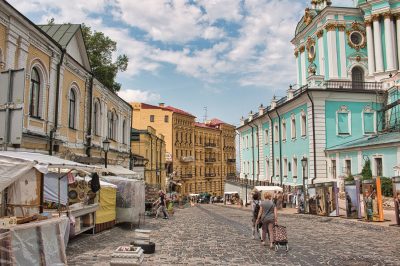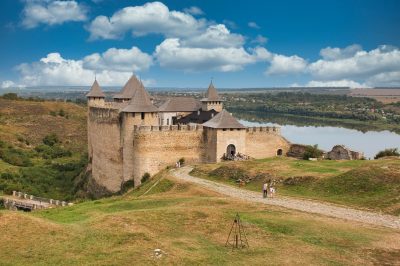I have to admit that riding the subway is not one of my favorite things to do. Whether in New York, Berlin or Munich, the stops often seem lovelessly designed and are also often a bit scruffy. In Kyiv, however, things are different. I look forward to a ride on the Kyiv Metro every time I’m in the city. You can find out why in this article. But first, I would like to introduce you to the Kyiv Metro. And if you are interested in Kyiv, the capital of Ukraine, in general, then just click here and get to our article with the most beautiful Kyiv sights.
History of the Kyiv Metro
The Kyiv Metro has existed since 1960, when Ukraine was part of the Soviet Union and Saint Petersburg and Moscow already had metros. Actually, Kyiv was supposed to get a metro already in 1942, but due to the German invasion of the Soviet Union it did not happen. Work on the metro Metro Kiev, as it was called in Russian, began in 1949.
Difficult circumstances
The work proved to be difficult, mainly due to the subsoil. The Dnipro, the Ukrainian lifeline, also flows through the capital and reaches a width of over a kilometer here! No wonder that the river digs deep into its bed and one had to dig much deeper to create underground stations. But that was precisely the point, because the intention was not only to create a practical means of transportation, but also to illustrate the superiority of socialist engineering achievements.

Opening of the Kiev Metro and expansion of the route network
On November 6, 1960, the time had finally come: After eleven years of construction, the first Kyiv Metro set off. It started directly on the Dnipro River at the Dnipro stop and ran to the Voksalna station, i.e. to the main train station. Even today, this line is the heart of Line 1, which was then called the Svyatoshinsko-Brovarska Line. Shortly afterwards, the line was extended to the west, and in 1965 it was extended to the east. Thus, for the first time, the new residential areas east of the Dnipro River in the Darnitsa region were made accessible. In the course of time the line was extended more and more and today it includes 18 stations on a distance of about 19 km. The stations of Line 1 are the most beautiful in Kyiv.
In 1976, a second line was opened, the Kurenivsko-Chervonarmiyska line, which today operates as Line 2. It runs once from north to south. Today the line is almost 21 km long. It crosses Line 1 and Line 3. Unusually, the crossing stations have different names depending on the line, something not known in the West.
Finally, Line 3 is the longest line of the Kyiv Metro with almost 24 kilometers. Just like Line 1, it also stretches across both banks of the Dnipro It was put into service only in 1989, shortly before the collapse of the Soviet Union. Here you can also take the longest ride without interruption, because it takes a few minutes to get from Slavutich station to Vydubichi.
Construction is currently underway on the fourth line, and a fifth and sixth line are also planned.
Stations of the Kyiv Metro – cathedrals under the ground
The Kyiv Metro was not only intended to emphasize the engineering achievements of the Soviet Union. In the atheist country, the stations served as substitute cathedrals, so to speak, and were perfectly suited to convey political values in the spirit of the regime. Cars, after all, were few and almost everyone had to take the metro in Kyiv. And so not only very beautiful, but also historically interesting stations were built. We present the most exciting ones here, most of which are on line 1.
Shuljavska (Line 1)

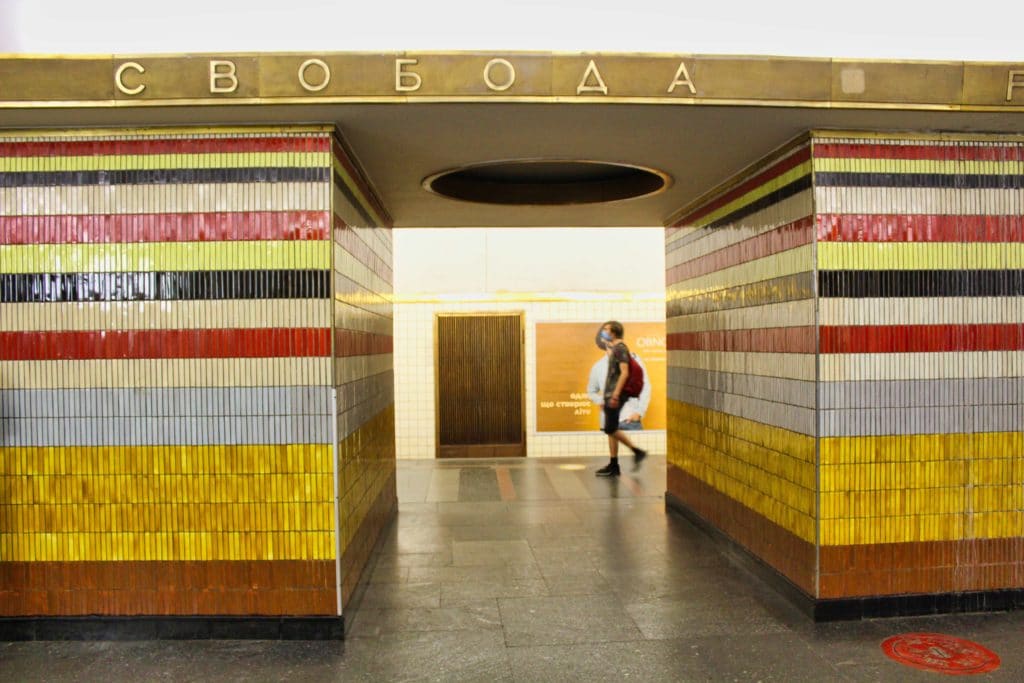
We start our metro ride at the Shulyavska station in the west of the city. It was opened in 1963 and was originally called Bolshevik. Here, the focus is on the communist worker. One mosaic shows a worker holding an atom as a symbol of nuclear power. The many other colorful mosaics here look a bit like they came out of grandma’s bathroom and are not quite as modern. The communist slogans above the entrances to the trains are also exciting. On one side they were Russian, on the other Ukrainian. The Russian letters have since been knocked out, but their traces can still be seen. Slogans such as “Labor,” “Brotherhood” and “Peace” can therefore only be seen in Ukrainian.
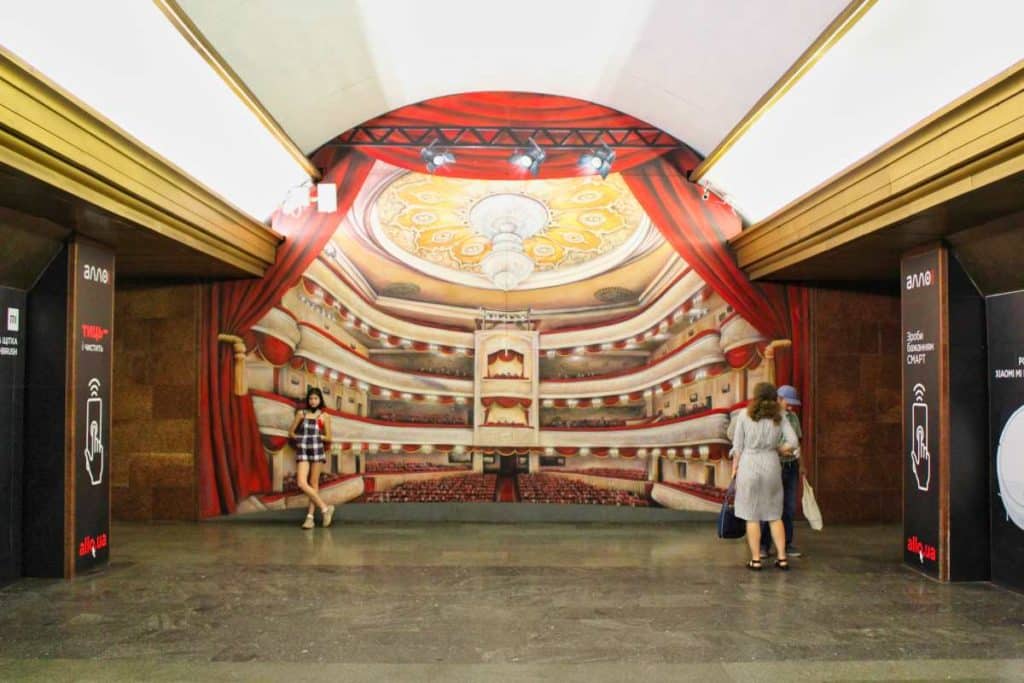
Teatralna (Line 1)
We continue our ride to Teatralna station in the very center of Kyiv. It used to bear the name Leninska. When it was opened in 1987, a large bust of Lenin stood here. This has since been removed. A Lenin relief was replaced as recently as 2014 by a somewhat kitschy painting depicting the neighboring Kyiv Opera House. The station looks a bit gloomy, which is due to the massive red marble that has been used everywhere here, reminiscent of the Lenin Mausoleum in Moscow. From the Teatralna station you can walk to the Soloti Vorota crossing station, which we describe below.

Arsenala (Line 1)
The Arsenalna metro station is relatively unspectacular inside. But what makes it so special is its depth. 105.5 m below ground, it is the deepest metro station in the world! The trip down the escalator takes a few minutes. Beautiful is the pavilion, through which you get to the metro Arsenalna. In front of it there is also a small monument with an artillery piece. It reminds that here in 1918 Ukrainian troops under Simon Petlyura and Yevhen Konovalez fought against the communists.
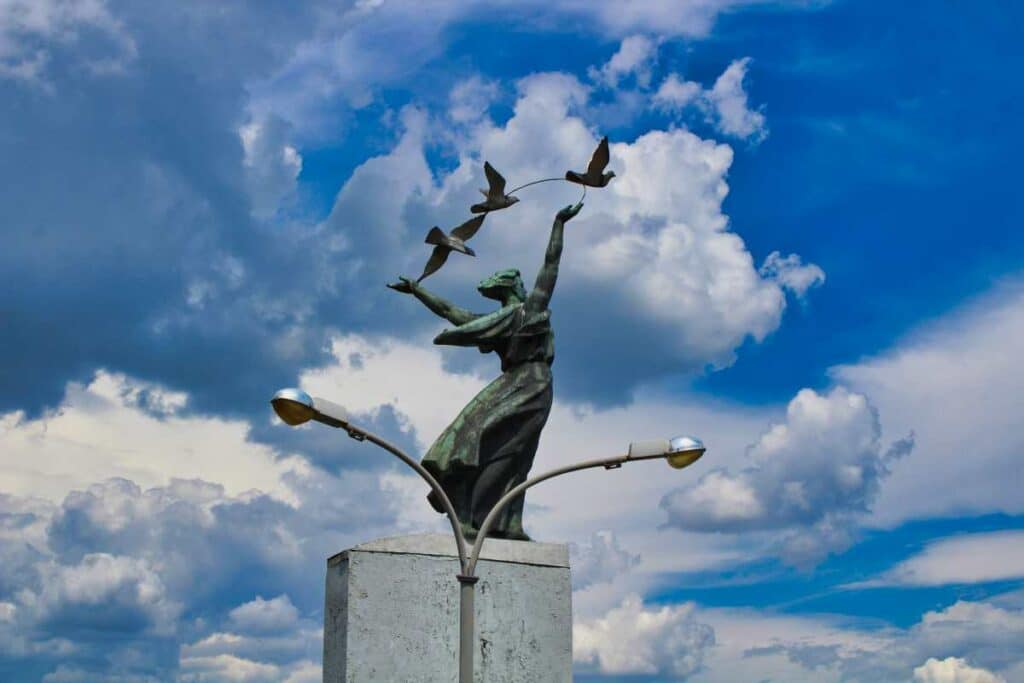
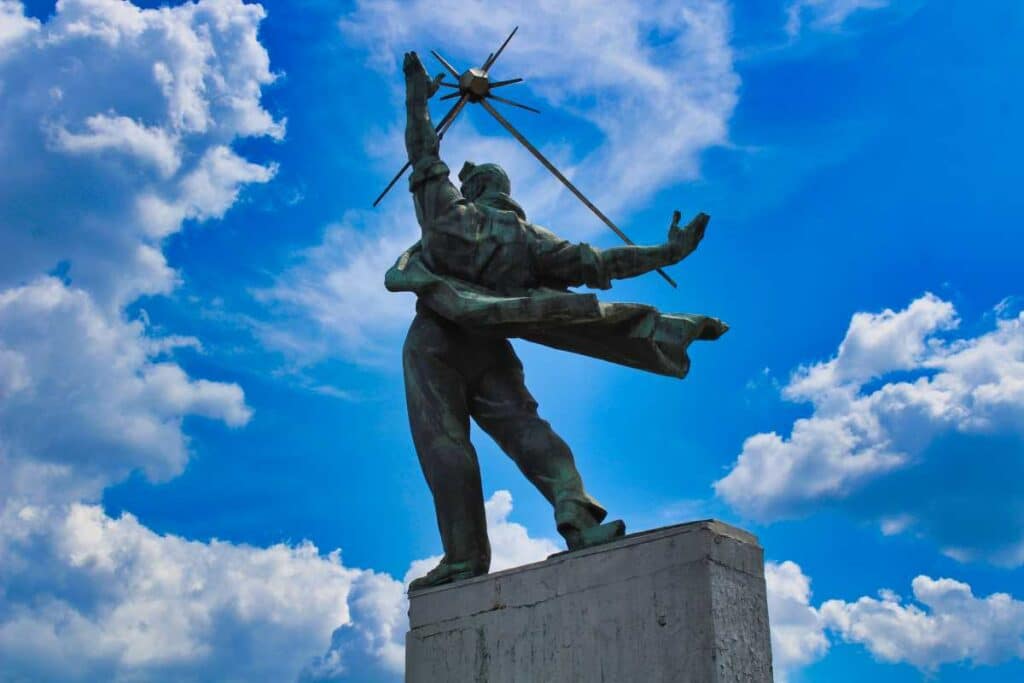
Dnipro (Line 1)
If you continue east, the next station is Dnipro. It is one of the most spectacular in Kyiv. The Kyiv Metro does not always run underground, but partly above ground. The Kyiv Metro thus struggles to rise more than 100 meters between Arsenalna and Dnipro stations, leaving the darkness here. The station is crowned by two huge Soviet statues. One shows a pioneer with a Sputnik satellite. Its female counterpart is surrounded by doves, symbolizing the peace that life under communism was supposed to hold.

Lybidska (Line 2)
Enough of line 1? There are many beautiful Kyiv Metro stations on Line 2 as well. Lybidska station, for example, was opened in 1984. It was originally named after Feliks Dzierżyński, the former Soviet intelligence chief. Worth seeing here are especially the bending double arches. Here you can see how the design has changed compared to the much older Line 1.
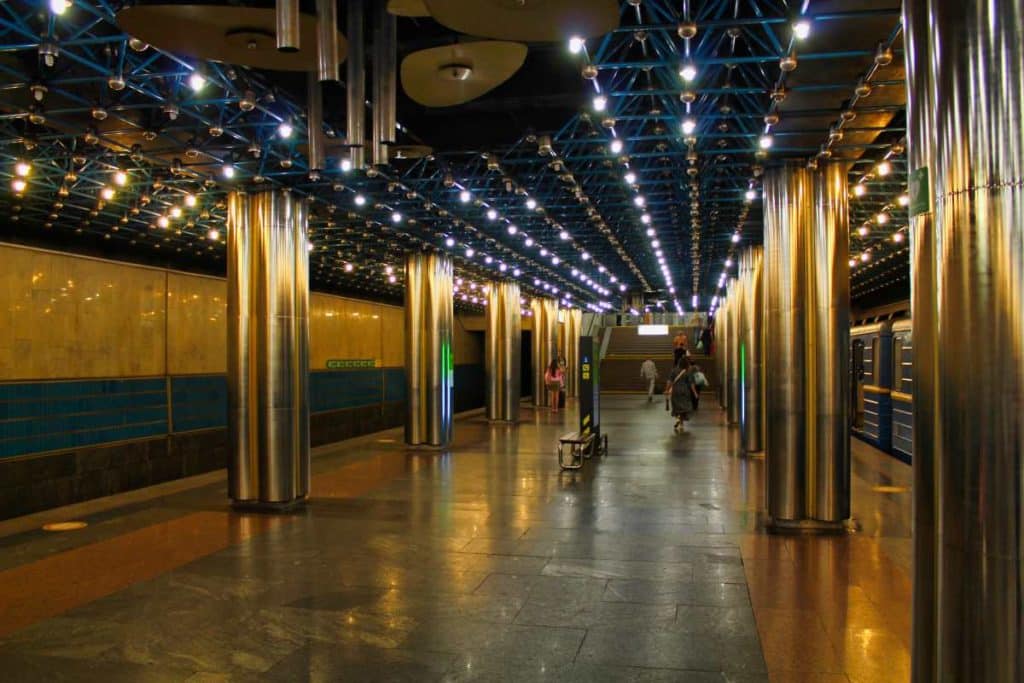
Slavutich (Line 3)
Welcome to the disco. At the Slavutich station, I didn’t want to get off at first, but then I was dazzled by all the lights. And honestly, it really does feel a bit like a futuristic club. Certainly one of the most unusual metro stations in Kyiv. The station was inaugurated in 1992, just after independence. An aluminum ceiling, stainless metal columns and the unique lighting make you feel like you’re under a starry sky here.

Soloti Vorota (Line 3)
Soloti Vorota is one of the most beautiful underground stations in Kyiv. And if there were no metro here, you would think you were back in the Middle Ages. Yet the station in the center of Kyiv was only opened in 1989. The magnificent chandeliers and the many detailed mosaics create an atmosphere worthy of a cathedral and correspond perfectly with the white marble. The mosaics depict all the rulers of Kyiv Rus from the 11th to the 13th century and have been protected as monuments since 2011.
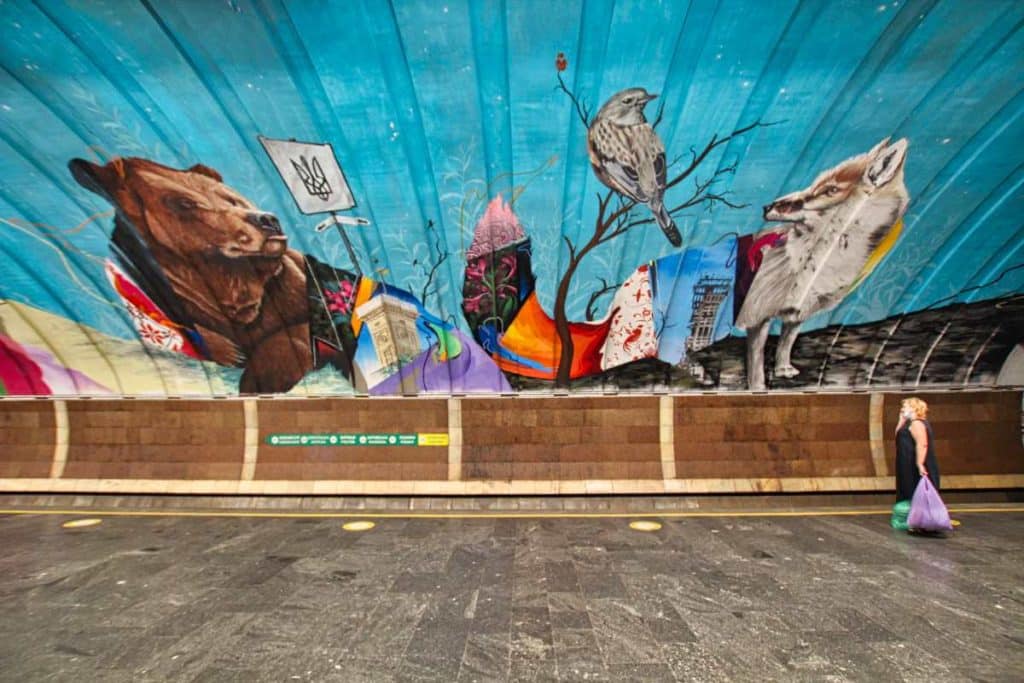


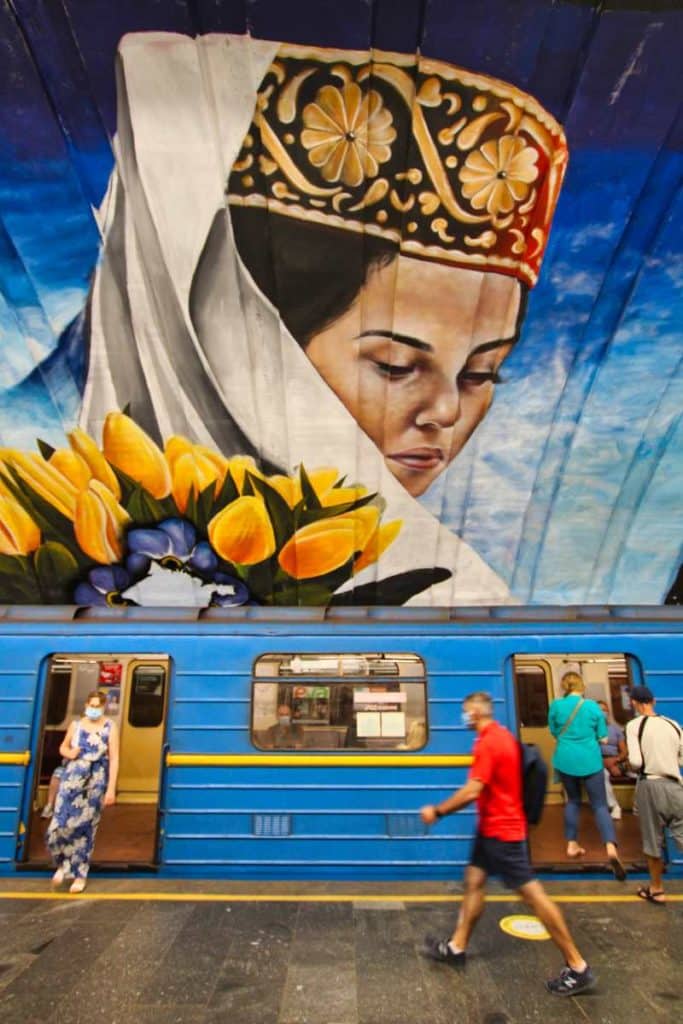
Osokorky (Line 3)
Last but not least – my absolute favorite station. Osokorky is located across the Dnipro River and was opened in 1992. Originally, it was one of the most boring stations of all and kept in plain white. No tourist would ever have thought of getting off here if numerous street artists hadn’t been given free rein at the end of 2018. And what has emerged is really something to behold. The artworks are quite political and deal with the conflict over Crimea and the east of the country.
I hope you enjoyed our ride!
No products found.
No products found.
What are your favorite stations in Kyiv and which is the most beautiful metro in the world for you? Let us know and write a comment!


